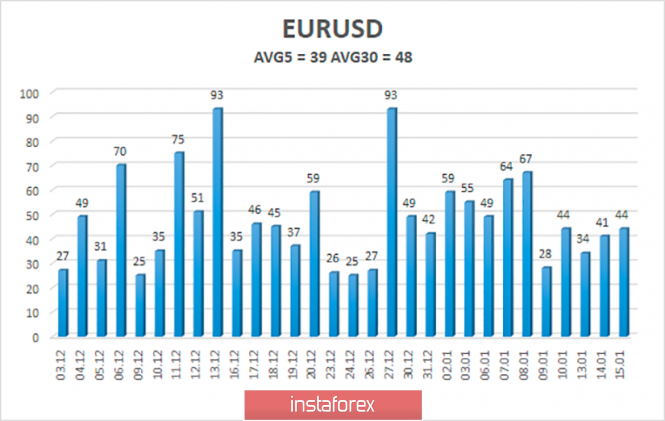4-hour timeframe

Technical data:
The upper channel of linear regression: direction - upward.
The lower channel of linear regression: direction - upward.
The moving average (20; smoothed) - up.
CCI: 130.5286
On Thursday, January 16, the EUR/USD currency pair begins a new round of upward movement. The pair's quotes have successfully overcome the moving average line and can now continue to move up since the initiative in the market is now concentrated in the hands of the bulls. At the same time, we still doubt that the euro will be able to continue its strengthening. The problem is that the fundamental background remains not in favor of the euro. This applies to the general fundamental background (ECB - Fed monetary policies, the current state of the US and EU economies), and the local macroeconomic background. Recent macroeconomic reports have again shown that the US economy continues to grow and strengthen, while the European Union remains in recession. Moreover, the signing of a trade agreement between China and the United States can lead to even greater growth of the American economy, while it can only help the European economy to stop shrinking. Anyway, the US economy looks much stronger and more stable than the European one, and the US dollar has a much better chance of strengthening.
Today, several macroeconomic reports will be published at once, which may have an impact on the movement of the euro-dollar pair. First, it is inflation in Germany. The consumer price index in December may reach 1.5% y/y, however, bearing in mind how inflation failed in the UK yesterday, we can assume that the German indicator is unlikely to show an acceleration. And if there is no acceleration, then there will be no new reasons for traders to buy the European currency. Second, the States will publish data on retail sales for December today. This is not the most important and significant indicator, the forecasts for it are relatively neutral, however, it can have a certain impact on the market. Retail sales are expected to have increased by 0.3% m/m in December. Third, the head of the European Central Bank, Christine Lagarde, will give a speech late in the evening. And we also don't expect anything optimistic for the European currency from this event. What can Lagarde say if she touches on monetary policy at all? The EU economy is still in a state of declining growth. Some industries (business activity, industrial production) are frankly declining. In such circumstances, Ms. Lagarde cannot even theoretically say anything "hawkish". Of course, the head of the ECB may try to calm the markets by saying something that does not quite correspond to the truth, but market participants must also believe in her words. Thus, we believe that the best balance for the euro today is inflation in Germany, which is 1.5% y/y, and Christine Lagarde, who does not touch the topic of monetary policy or chooses the most neutral rhetoric.
Meanwhile, US President Donald Trump and Vice Premier of the State Council of China Liu He signed the documents of the first stage of the trade deal. As previously reported, duties of 25% on imports from China totaling $250 billion remain in force. President Trump noted that he decided to keep these duties, as otherwise "America would have lost all the trumps in the negotiations on the second phase." Chinese President Xi Jinping called the deal a sign that the parties can resolve their differences through dialogue. He called the agreement beneficial for Beijing, Washington, and the world. Meanwhile, the European Chamber of Commerce started sounding the alarm over the signing of the agreement between China and the United States. According to the head of the organization, Jorg Wuttke, "regulated trade" between China and America will hit exporters and manufacturers of other countries, since now Beijing will buy those goods that America will prescribe, respectively, excluding other manufacturers and suppliers from the market, as well as leveling the principle of "best price and best conditions". Another potential blow to the European economy?

The average volatility of the euro-dollar currency pair is currently 39 points and continues to decline. Thus, we have volatility levels on January 16 - 1.1110 and 1.1187. A reversal of the Heiken Ashi indicator will indicate a downward correction. We still expect the downward movement to resume.
Nearest support levels:
S1 - 1.1139
S2 - 1.1108
S3 - 1.1078
Nearest resistance levels:
R1 - 1.1169
R2 - 1.1200
R3 - 1.1230
Trading recommendations:
The euro-dollar pair broke the moving average line. Thus, long positions with goals of 1.1169 and 1.1187 have become relevant at the moment. However, a downward reversal of the Heiken Ashi may signal the end of the entire upward momentum. It is recommended to return to the pair's sales with the goal of 1.1110 not earlier than the reverse overcoming of the moving average.
In addition to the technical picture, you should also take into account the fundamental data and the time of their release.
Explanation of the illustrations:
The upper channel of linear regression - the blue lines of the unidirectional movement.
The lower channel of linear regression - the purple lines of the unidirectional movement.
CCI - the blue line in the indicator window.
The moving average (20; smoothed) - the blue line on the price chart.
Murray levels - multi-colored horizontal stripes.
Heiken Ashi - an indicator that colors bars in blue or purple.
Possible variants of the price movement:
Red and green arrows.
The material has been provided by InstaForex Company - www.instaforex.com